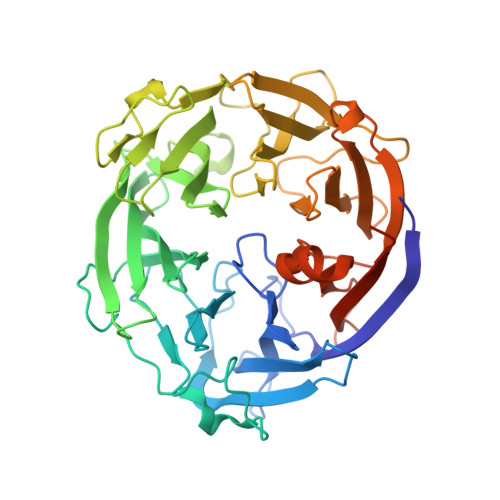Charge neutralization and beta-elimination cleavage mechanism of family 42 L-rhamnose-alpha-1,4-D-glucuronate lyase revealed using neutron crystallography.
Yano, N., Kondo, T., Kusaka, K., Arakawa, T., Sakamoto, T., Fushinobu, S.(2024) J Biol Chem 300: 105774-105774
- PubMed: 38382672
- DOI: https://doi.org/10.1016/j.jbc.2024.105774
- Primary Citation of Related Structures:
7YQS, 8I4D - PubMed Abstract:
Gum arabic (GA) is widely used as an emulsion stabilizer and edible coating and consists of a complex carbohydrate moiety with a rhamnosyl-glucuronate group capping the non-reducing ends. Enzymes that can specifically cleave the glycosidic chains of GA and modify their properties are valuable for structural analysis and industrial application. Cryogenic X-ray crystal structure of GA-specific L-rhamnose-α-1,4-D-glucuronate lyase from Fusarium oxysporum (FoRham1), belonging to the polysaccharide lyase (PL) family 42, has been previously reported. To determine the specific reaction mechanism based on its hydrogen-containing enzyme structure, we performed joint X-ray/neutron crystallography of FoRham1. Large crystals were grown in the presence of L-rhamnose (a reaction product), and neutron and X-ray diffraction datasets were collected at room temperature at 1.80 and 1.25 Å resolutions, respectively. The active site contained L-rhamnose and acetate, the latter being a partial analog of glucuronate. Incomplete H/D exchange between Arg166 and acetate suggested that a strong salt-bridge interaction was maintained. Doubly deuterated His105 and deuterated Tyr150 supported the interaction between Arg166 and the acetate. The unique hydrogen-rich environment functions as a charge neutralizer for glucuronate and stabilizes the oxyanion intermediate. The NE2 atom of His85 was deprotonated and formed a hydrogen bond with the deuterated O1 hydroxy of L-rhamnose, indicating the function of His85 as the base/acid catalyst for bond cleavage via β-elimination. Asp83 functions as a pivot between the two catalytic histidine residues by bridging them. This His-His-Asp structural motif is conserved in the PL 24, 25, and 42 families.
Organizational Affiliation:
Structural Biology Division, Japan Synchrotron Radiation Research Institute, Hyogo, Japan. Electronic address: [email protected].




















